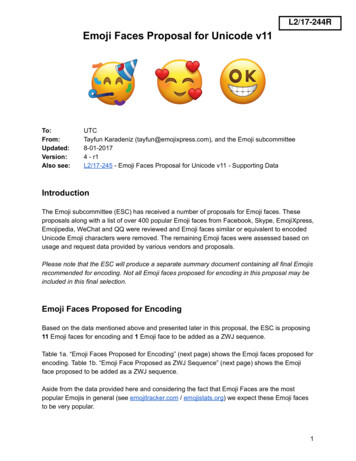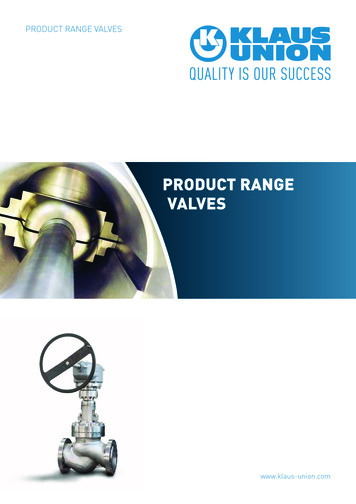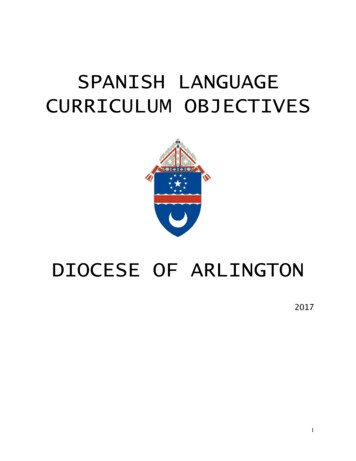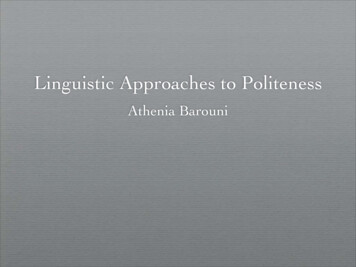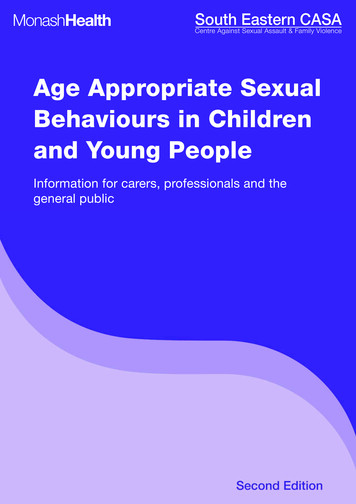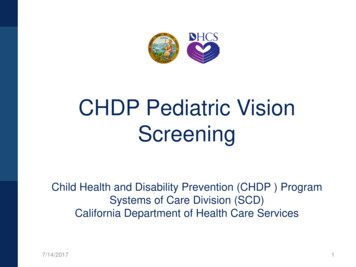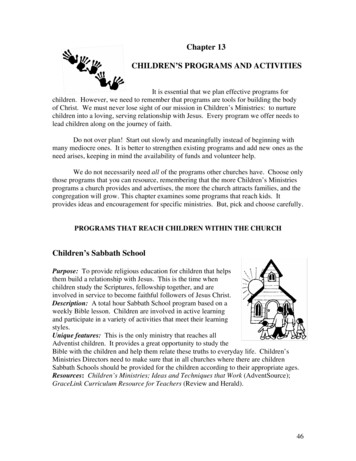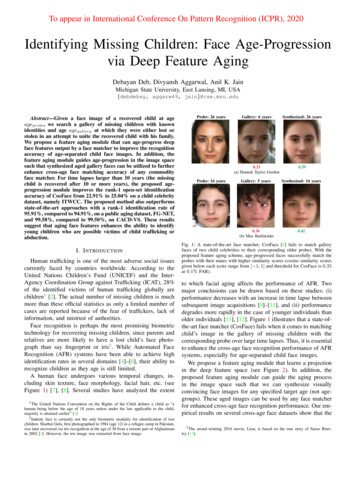
Transcription
To appear in International Conference On Pattern Recognition (ICPR), 2020Identifying Missing Children: Face Age-Progressionvia Deep Feature AgingDebayan Deb, Divyansh Aggarwal, Anil K. JainMichigan State University, East Lansing, MI, USA{debdebay, aggarw49, jain}@cse.msu.eduAbstract—Given a face image of a recovered child at ageageprobe , we search a gallery of missing children with knownidentities and age agegallery at which they were either lost orstolen in an attempt to unite the recovered child with his family.We propose a feature aging module that can age-progress deepface features output by a face matcher to improve the recognitionaccuracy of age-separated child face images. In addition, thefeature aging module guides age-progression in the image spacesuch that synthesized aged gallery faces can be utilized to furtherenhance cross-age face matching accuracy of any commodityface matcher. For time lapses larger than 10 years (the missingchild is recovered after 10 or more years), the proposed ageprogression module improves the rank-1 open-set identificationaccuracy of CosFace from 22.91% to 25.04% on a child celebritydataset, namely ITWCC. The proposed method also outperformsstate-of-the-art approaches with a rank-1 identification rate of95.91%, compared to 94.91%, on a public aging dataset, FG-NET,and 99.58%, compared to 99.50%, on CACD-VS. These resultssuggest that aging face features enhances the ability to identifyyoung children who are possible victims of child trafficking orabduction.I. I NTRODUCTIONHuman trafficking is one of the most adverse social issuescurrently faced by countries worldwide. According to theUnited Nations Children’s Fund (UNICEF) and the InterAgency Coordination Group against Trafficking (ICAT), 28%of the identified victims of human trafficking globally arechildren1 [2]. The actual number of missing children is muchmore than these official statistics as only a limited number ofcases are reported because of the fear of traffickers, lack ofinformation, and mistrust of authorities.Face recognition is perhaps the most promising biometrictechnology for recovering missing children, since parents andrelatives are more likely to have a lost child’s face photograph than say fingerprint or iris2 . While Automated FaceRecognition (AFR) systems have been able to achieve highidentification rates in several domains [4]–[6], their ability torecognize children as they age is still limited.A human face undergoes various temporal changes, including skin texture, face morphology, facial hair, etc. (seeFigure 1) [7], [8]. Several studies have analyzed the extent1 The United Nations Convention on the Rights of the Child defines a child as “ahuman being below the age of 18 years unless under the law applicable to the child,majority is attained earlier” [1]2 Indeed, face is certainly not the only biometric modality for identification of lostchildren. Sharbat Gula, first photographed in 1984 (age 12) in a refugee camp in Pakistan,was later recovered via iris recognition at the age of 30 from a remote part of Afghanistanin 2002 [3]. However, the iris image was extracted from face imageProbe: 26 yearsProbe: 16 yearsGallery: 6 yearsSynthesized: 26 years0.33(a) Hannah Taylor Gordon0.39Gallery: 5 yearsSynthesized: 16 years0.34(b) Max Burkholder0.42Fig. 1: A state-of-the-art face matcher, CosFace [4] fails to match galleryfaces of two child celebrities to their corresponding older probes. With theproposed feature aging scheme, age-progressed faces successfully match theprobes with their mates with higher similarity scores (cosine similarity scoresgiven below each score range from [ 1, 1] and threshold for CosFace is 0.35at 0.1% FAR).to which facial aging affects the performance of AFR. Twomajor conclusions can be drawn based on these studies: (i)performance decreases with an increase in time lapse betweensubsequent image acquisitions [9]–[11], and (ii) performancedegrades more rapidly in the case of younger individuals thanolder individuals [11], [12]. Figure 1 illustrates that a state-ofthe-art face matcher (CosFace) fails when it comes to matchingchild’s image in the gallery of missing children with thecorresponding probe over large time lapses. Thus, it is essentialto enhance the cross-age face recognition performance of AFRsystems, especially for age-separated child face images.We propose a feature aging module that learns a projectionin the deep feature space (see Figure 2). In addition, theproposed feature aging module can guide the aging processin the image space such that we can synthesize visuallyconvincing face images for any specified target age (not agegroups). These aged images can be used by any face matcherfor enhanced cross-age face recognition performance. Our empirical results on several cross-age face datasets show that the2 The award-winning 2016 movie, Lion, is based on the true story of Saroo Brierley [13].
Style ���ID EncoderIDFeatureEnrollment Age: 6Enrollment Age: 6Target Age: 26ℒ𝐼𝐼𝐼𝐼Synthesized Image(Age 26)FeatureAging ModuleConcatenationBackward Propagationℒ𝐹𝐹𝐹𝐹𝐹𝐹Forward PropagationTarget Age: 26Fig. 2: Overview of training the proposed child face aging framework. The feature module guides the decoder to synthesize a face image to any specifiedtarget age while the style-encoder injects style from the input probe into the synthesized face. LID represents the Identity-Preservation loss, Lpix representsthe pixel supervision loss and LF AM represents the loss for the Feature Aging Module. For simplicity, we omit the total variation loss (LT V ).proposed feature aging module, along with the age-progressed3images, can improve the cross-age face recognition performance of three face matchers (FaceNet [5], CosFace [4],and a commercial-off-the-shelf (COTS) matcher) for matchingchildren as they age.The specific contributions of the paper are as follows: A feature aging module that learns to traverse the deepfeature space to preserve subject identity while aging theface to enhance cross-age matching.An image aging scheme, guided by our feature agingmodule, to synthesize an age-progressed or age-regressedface image at any specified target age. The aged faceimages can also improve cross-age face recognition performance for any commodity face matcher.Improved identification (closed-set and open-set) accuracy compared to state-of-the-art face matchers, CosFace [4], FaceNet [5], and a COTS, on two different childface aging datasets: CFA and ITWCC [14]. In addition,the proposed module boosts accuracies on two publicface aging benchmark datasets, FG-NET [15] and CACDVS [16]4 .3 Though our module is not strictly restricted to age-progression, we use the wordprogression largely because in the missing children scenario the gallery would generallybe younger than the probe. Our module does both age-progression and age-regressionwhen we benchmark our performance on public datasets.4 We follow the protocols provided with these datasets.II. R ELATED W ORKA. Discriminative ApproachesApproaches prior to deep learning leveraged robust local descriptors [17]–[21] to tackle recognition performancedegradation due to face aging. Recent approaches focus onage-invariant face recognition by attempting to discard agerelated information from deep face features [22]–[26]. Allthese methods operate under two critical assumptions: (i) ageand identity related features can be disentangled, and (ii)the identity-specific features are adequate for face recognitionperformance. On the other hand, several other studies showthat age is indeed a major contributor to face recognitionperformance [27], [28]. Therefore, instead of completely discarding age factors, we exploit the age-related information toprogress or regress the deep feature directly to the desired age.B. Generative ApproachesOngoing studies leverage Conditional Auto-encoders andGenerative Adversarial Networks (GANs) to synthesize facesby learning aging patterns from face aging datasets [25], [29]–[34]. The primary objective of these methods is to synthesizevisually realistic face images that appear to be age progressed.As a result, a majority of these studies do not report the facerecognition performance on the synthesized faces.5 MORPH: https://bit.ly/31P6QMw, CACD: https://bit.ly/343CdVd, FG-NET: https://bit.ly/2MQPL0O, UTKFace: https://bit.ly/2JpvX2b
TABLE I: Face aging datasets. Datasets below solid line includes cross-age face images of children.DatasetMORPH-II [35]CACD [16]FG-NET [15]UTKFace [30]†ITWCC [36]CLF [12]CFA†††No. of Subjects13,0002,00082N/A7459199,196No. of Images55,134163,4461,00223,7087,9903,68225,180Age Range (years) Avg. Age (years) 13No††2-188No††2-2010No††No. Images / Subject2-53 (avg. 4.2)22-139 (avg. 81.7)6-18 (avg. 12.2)N/A3-37 (avg. 10.7)2-6 (avg. 4.0)2-6 (avg. 2.7)Dataset does not include subject labels; Only a collection of face images along with the corresponding ages.Concerns about privacy issues are making it extremely difficult for researchers to place the child face images in public domain.TABLE II: Related work on age-separated face recognition. Studies below bold line deal with children.StudyObjectiveDatasetAge progression of face imagesMORPH-II, CACD31-40, 41-50, 50 Decomposing age and identityMORPH-II, FG-NET, CACD0-12, 13-18, 19-25, 26-35, 36-45,46-55, 56-65, 65 Best-Rowden et al. [37]Model for change in genuine scores over timePCSO, MSP18-83Ricanek et al. [36]Face comparison of infants to adultsITWCC0-33Deb et al. [12]Feasibility study of AFR for childrenCLF2-18This studyAging face features for enhanced AFR for childrenCFA, ITWCC, FG-NET, CACD0-18Yang et al. [31]*Wang et al. [26]**Age groups or range (years)Study uses cross-sectional model (ages are partitioned into age groups) and not the correct longitudinal model [10], [38].C. Face Aging for ChildrenBest-Rowden et al. studied face recognition performance ofnewborns, infants, and toddlers (ages 0 to 4 years) on 314subjects acquired over a time lapse of only one year [39].Their results showed a True Accept Rate (TAR) of 47.93%at 0.1% False Accept Rate (FAR) for an age group of [0, 4]years for a commodity face matcher. Deb et al. fine-tunedFaceNet [5] to achieve a rank-1 identification accuracy of77.86% for a time lapse between the gallery and probe imageof 1 year. Srinivas et al. showed that the rank-1 performance ofstate of the art commercial face matchers on longitudinal faceimages from the In-the-Wild Child Celebrity (ITWCC) [14]dataset ranges from 42% to 78% under the youngest to olderprotocol. These studies primarily focused on evaluating thelongitudinal face recognition performance of state-of-the-artface matchers rather than proposing a solution to improveface recognition performance on children as they age. Table Isummarizes cross-age face datasets that include children andTable II shows related work in this area.III. P ROPOSED A PPROACHSuppose we are given a pair of face images (xe , yt ) for achild acquired at ages e (enrollment) and t (target), respectively. Our goal is to enhance the ability of state-of-the-artface recognition systems to match xe and yt when (e t).We propose a feature aging module that learns a projectionof the deep features in a lower-dimensional space which candirectly improve the accuracy of face recognition systems inidentifying children over large time lapses. The feature agingmodule guides a generator to output aged face images thatcan be used by any commodity face matcher for enhancingcross-age face recognition performance.A. Feature Aging Module (FAM)It has been found that age-related components are highlycoupled with identity-salient features in the latent space [27],[28]. That is, the age at which a face image is acquiredcan itself be an intrinsic feature in the latent space. Insteadof disentangling age-related components from identity-salientfeatures, we would like to automatically learn a projectionwithin the face latent space.Assume xe X and yt Y where X and Y are twoface domains when images are acquired at ages e and t, respectively. Face manipulations via generative approaches [25],[29]–[34] shift images in the domain of X to Y via,yˆt F(xe , e, t)(1)where, yˆt is the output image and F is the operator thatchanges xe from X to Y. Domains X and Y generally differin factors other than aging, such as noise, quality and pose.Therefore, F can be highly complex. We can simplify Fby modeling the transformation in the deep feature space bydefining an operator F 0 and rewrite equation 1yˆt F 0 (ψ(xe ), e, t)(2)where ψ(xe ) is an encoded feature in the latent space. Here, F 0learns a projection in the feature space that shifts an image xein X to Y and therefore, ‘ages’ a face feature from age e to aget. Since face representations lie in d-dimensional Euclideanspace6 , the latent space Z is linear. That is, given any faceimage, face recognition systems encode the features in alinear space where operations, such as matching face features,are performed linearly. Since one of our primary goals is toimprove the performance of the face recognition system in itslatent space, we have to learn a linear transformation. Nonlinearity will result in leaving the latent space completely andwill fail to match. Therefore, F 0 is a linear shift in the deepspace, that is,yˆt F 0 (ψ(xe ), e, t) W (ψ(xe ) e t) b(3)6 Assume these feature vectors are constrained to lie in a d-dimensional hypersphere, i.e., ψ(x) 22 1.
where W Rd d and b Rd are learned parameters of F 0and is concatenation. Since some face features, such as eyecolor, do not change drastically during the aging process, thescale parameter, W allows for each feature to scale differentlygiven the enrollment and target ages.Upchurch et al. [40] explored a similar idea of linearlyinterpolating features in the deep feature space. However, theyperformed linear interpolation by computing the mean featuresof two age clusters and moving along that direction by amanually specified “scale” hyperparameter. In contrast, ourmodel can directly model the age clusters without the need fora scale parameter. In other words, deep linear interpolation isa handcrafted version of our automatic feature aging module.B. Image GeneratorWhile FAM can directly output face embeddings that canbe used for face recognition, FAM trained on the latentspace of one matcher may not generalize to feature spacesof other matchers. Still, the feature aging module trainedfor one matcher can guide the aging process in the imagespace. In this manner, an aged image can be directly usedto enhance cross-age face recognition performance for anycommodity face matcher without requiring any re-training.The aged images should (i) enhance identification performanceof any commodity face matcher under aging, and (ii) appearvisually realistic to humans.IV. L EARNING FACE AGINGOur proposed framework for face aging comprises of threemodules, (i) feature aging module (FAM), (ii) style-encoder,and (iii) decoder. For training these three modules, we utilizea fixed ID encoder (EID ) that outputs a deep face featurefrom an input face image. An overview of our proposed agingframework is given in Figure 2.A. Feature Aging Module (FAM)This module consists of a series of fully connected layersthat learn the scale W and bias b parameters in Equation 3.The training set consists of a genuine pair of face features(ψ(xe ), ψ(yt )) extracted from an identity encoder (EID ),where xe and yt are two images of the same person acquired atages e and t, respectively. In order to ensure that the identitysalient features are preserved and the synthesized features areage-progressed to the desired age t, we train FAM via a meansquared error (MSE) loss which measures the quality of thepredicted features:1 X F 0 (ψ(xe ), e, t) ψ(yt ) 22 , (4)LF AM P LF AM forces the FAM module to retain all other covariates inthe predicted features from the input features. After the modelis trained, FAM can progress a face feature to the desired age.B. Style-EncoderThe ID encoder (EID ) encodes specific information pertaining to the identity of a person’s face. However, a face imagecomprises of other pixel-level residual features that may notrelate to a person’s identity but are required for enhancing thevisual quality of the synthesized face image, which we refer toas style. In fact, directly decoding a face feature vector into animage can severely affect the visual quality of the synthesizedface. Therefore, we utilize a style-encoder (Estyle ) that takes aface image, x, as an input and outputs a k-dimensional featurevector that encodes style information from the image.C. DecoderIn order to synthesize a face image, we propose a decoderD that takes as input a style and an ID vector obtained fromEstyle and EID , respectively, and outputs a synthesized imageŷ. For training D, we do not require the aged features predictedby the feature aging module, since we enforce the predictedaged features to reside in the latent space of EID .a) Identity-Preservation: Our goal is to synthesize agedface images that can benefit face recognition systems. Therefore, we need to constrain the decoder D to output face imagesthat can be matched to the input image. To this end, we adoptan identity-preservation loss to minimize the distance betweenthe input and synthesized face images of the decoder in theEID ’s latent space,LID nXi 0where xi are samples in the training set. Note that the taskof the decoder is just to take as input a style vector andan ID vector and synthesize the corresponding image. Tosynthesize the age progressed image, the ID vector can bereplaced by the aged ID vector output from FAM at test time.Therefore, the identity preservation loss is maintained betweenthe synthesized and the input image as opposed to betweensynthesized and target image.b) Pixel-level Supervision: In addition to identitypreservation, a pixel-level loss is adopted to maintain theconsistency of low-level image content between the input andoutput of the decoder,Lpix (i,j) Pwhere P is the set of all genuine pairs. Globally, let Se andSt represent all the face images at ages e and t, respectively.Since there is no other systematic bias except for the differencein the ages of these two sets of face images, therefore,when Mean Squared Error is used for training, FAM learnsa projection along the age direction keeping other covariates(e.g. expression, pose etc) intact. Our experiments show that EID (D(Estyle (xi ), EID (xi ))) EID (xi ) 22 (5)nX D(Estyle (xi ), EID (xi )) xi 1(6)i 0To synthesize a smooth image, devoid of sudden changesin high-frequency pixel intensities, we regularize the totalvariation in the synthesized image,"H,W#nXXh 2 2 iLT V xir 1,c xir,c xir,c 1 xir,ci 0r,c(7)
5 years6 years3 years5 years8 years11 years12 years13 years(a) CFA(a) CFA(b) ITWCCFig. 4: Rank-1 search accuracy for CosFace [4] on (a) CFA and (b) ITWCCdatasets with and without the proposed Feature Aging Module (FAM).(b) ITWCC [14]Fig. 3: Examples of cross-age face images from (a) CFA and (b) ITWCC [14]datasets. Each row consists of images of one subject; age at image acquisitionis given above each imageOur final training objective for the style-encoder and decoder is,L(Estyle ,D) λID LID λpix Lpix λT V LT V(8)where λID , λpix , λT V are the hyper-parameters that controlthe relative importance of every term in the loss. We emperically set λID 1.0, λpix 10.0, and λtv 1e 4.We train the Feature Aging Module and the Image Generator in an end-to-end manner by minimizing L(Estyle ,D) andLF AM .V. I MPLEMENTATION D ETAILSa) Feature Aging Module: For all the experiments, westack two fully connected layers and set the output of eachlayer to be of the same dimensionality as the ID encoder’sfeature vector. We train the proposed framework for 200, 000iterations with a batch size of 64 and a learning rate of 0.0002using Adam optimizer with parameters β1 0.5, β2 0.99.In all our experiments, k 32. Implementations are providedin the supplementary materials.b) ID Encoder: For our experiments, we employ 3pre-trained face matchers7 . Two of them, FaceNet [5] andCosFace [4], are publicly available. FaceNet is trained onVGGFace2 dataset [41] using the Softmax Center Loss [5].CosFace is a 64-layer residual network [42] and is trainedon MS-ArcFace dataset [43] using AM-Softmax loss function [43]. Both matchers extract a 512-dimensional featurevector. We also evaluate results on a commercial-off-the-shelfface matcher, COTS8 .VI. E XPERIMENTSA. Cross-Age Face Recognitiona) Evaluation Protocol: We divide the subjects in CFAand ITWCC datasets into 2 non-overlapping sets which are7 Both the open-source matchers and the COTS matcher achieve 99% accuracy onLFW under its standard protocol.8 This particular COTS has been used for identifying children in prior studies [12],[14]. It is also one of the top performers in the NIST Ongoing Face Recognition VendorTest (FRVT) [11]. This is a closed system so we do not have access to its feature vectorand therefore only utilize COTS as a baseline.used for training and testing, respectively. Testing set ofITWCC consists of all subjects with image pairs separatedby at least a 10-year time lapse. Since, the maximum timelapse in the CFA dataset is 8 years, testing set of CFAconsists of all subjects with image pairs separated by at least5-year time lapse. As mentioned earlier, locating missingchildren is akin to the identification scenario, we computeboth the closed-set identification accuracy (recovered child isin the gallery) at rank-1 and the rank-1 open-set identificationaccuracy (recovered child may or may not be in the gallery) at1.0% False Accept Rate. For open-set identification scenarios,we extend the gallery of CFA by adding all images in thetesting of ITWCC and vice-versa. Remaining images of thesubject form the distractor set in the gallery. For the searchexperiments, we age all the gallery features to the age of theprobe and match the aged features (or aged images via ourImage Generator) to the probe’s face feature.b) Results: In Table III, we report the Rank-1 searchaccuracy of our proposed Feature Aging Module (FAM) aswell as accuracy when we search via our synthesized ageprogressed face images on CFA and ITWCC. We find that theage-progression scheme can improve the search accuracy ofboth FaceNet [5] and CosFace [4] matchers. Indeed, imagesaged via the FAM can also enhance the performance ofthese matchers which highlights the benefit of using boththe feature aging scheme and the Image Generator. With theproposed feature aging module, an open-source face matcherCosFace [4] can outperform the COTS matcher9 .We also investigate the Rank-1 identification rate withvarying time lapses between the probe and its true mate in thegallery in Figures 4a and 4b. While our aging model improvesmatching across all time lapses, its contribution gets larger asthe time lapse increases.In Figure 8, we show some example cases where CosFace [4], without the proposed deep feature aging module,retrieves a wrong child from the gallery at rank-1. With theproposed method, we can correctly identify the true mates forthe same probes at Rank-1.In order to evaluate the generalizability of our moduleto adults, we train it on CFA and ITWCC [14] datasets9 CosFace [4] matcher takes about 1.56ms to search for a probe in agallery of 10, 000 images of missing children. Our model takes approximately27.45ms (on a GTX 1080 Ti) to search for a probe through the same gallerysize.
TABLE III: Rank-1 identification accuracy on two child face datasets, CFA and ITWCC [14], when the time gap between a probe and its true mate in the gallery is larger than 5years and 10 years, respectively. The proposed aging scheme (in both the feature space as well as the image space) improves the performance of FaceNet and CosFace on cross-ageface matching. We also report the number of probes (P) and gallery sizes (G) for each experiment.MethodCOTS [14]FaceNet [5] (w/o FAM)FaceNet (with FAM)CosFace [4] (w/o FAM)CosFace (with FAM)CosFace (Image Aging)CFA (Constrained)Closed-setOpen-set†Rank-1Rank-1 @ 1% FARP: 642, G: 2213P: 3290, G: 4.2493.1892.47ITWCC (Semi-Constrained) [14]Closed-setOpen-set†Rank-1Rank-1 @ 1% FARP: 611, G: 2234P: 2849, G: 5.0464.8723.40†A probe is first claimed to be present in the gallery. We accept or reject this claim based on a pre-determined threshold @ 1.0% FAR (verification). If the probe isaccepted, the ranked list of gallery images which match the probe with similarity scores above the threshold are returned as the candidate list (identification).TABLE IV: Face recognition performance on FG-NET and CACD-VS.and benchmark our performance on publicly available agingdatasets, FG-NET [15] and CACD-VS [16]10 in Table IV. Wefollow the standard protocols [17], [20] for the two datasetsand benchmark our proposed FAM against baselines. We findthat the feature aging module enhances cross-age performanceof CosFace [4]. We also fine-tuned the last layer of CosFace onthe same training set as ours, however, the decrease in accuracysuggests that moving to a new latent space can negativelyimpact general face recognition performance. Our module canboost the performance while still operating in the same featurespace as the original matcher. While the two datasets docontain children, the protocol does not explicitly test large timegap between probe and gallery images of children. Therefore,we also evaluated the performance of the proposed approachon a subset children in FG-NET with the true mate and theprobe being separated by at least 10 years. The proposedmethod was able to boost the performance of Cosface from12.74% to 15.09%. Fig. 8 shows examples where the proposedapproach is able to retrieve the true mate correctly at Rank 1.B. Qualitative ResultsTo demonstrate the benefit of synthesized aged images, weshow aged images of 4 children in the ITWCC and CFAdatasets in Figure 5. Unlike prior generative methods [30]–[33], [45], [46], we can synthesize an age-progressed or ageregressed image to any desired age without adversely affectingthe identity information. The proposed Feature Aging Modulesignificantly contributes to a continuous aging process in theimage space where other covariates such as poses, quality, etc.remain unchanged from the input probes.10 Since CACD-VS does not have age labels, we use DEX [44] (a publicly availableage estimator) to estimate the ages.5 years10 years15 years20 years10 years3 years2 years6 yearsHFA [17]LF-CNN [22]AIM [25]Wang et al. [26]COTSCosFace [4] (w/o FAM)CosFace (finetuned on children)CosFace (with FAM)CACD-VS [15]Accuracy %5 yearsMethodFG-NET [15]Rank-1 %Fig. 5: Column 1 shows the probe images of 4 children. Rows 1 and 2 consistof two child celebrities from the ITWCC dataset [36] and rows 3 and 4are children from the CFA dataset. Columns 2-6 show the correspondingsynthesized aged images via the proposed Image Generator. Our approach canoutput an aged image at any desired target age while preserving the identity.Probe19 yearsTrue Mate7 yearsProposed(Tested on FaceNet)19 yearsFaceNet [5]3 years(a)Rank-43(b)Rank-1(c)(d)Fig. 6: (a) A probe image whose true mate is shown in (b). Without ouraging module, FaceNet retrieves the true mate at Rank-43 while image in (c)is retrieved at Rank-1. (d) With our aged image trained on CosFace, FaceNetcan retrieve the true mate at Rank-1.C. Generalization StudyPrior studies in the adversarial machine learning domainhave found that deep convolutional neural networks are highlytransferable, that is, different networks extract similar deepfeatures. Since our proposed feature aging module learnsto age features in the latent space of one matcher, directlyutilizing the aged features for matching via another matcher
.920.930.930.920.900.920.940.940.930.92Age Progression (0 to 30 years with 4 year time lapse)0.91Style(a)(b)Fig. 7: Interpolation between style, age, and identity. (a) Aged features extracted via proposed FAM do not alter other covariates (quality and pose), whilethe style transitions due to the style-encoder. (b) Gradual transitioning between style and identity indicates disentangled identity and style features.may not work. However, since all matchers extract featuresfrom face images, we tested the cross-age face recognitionperformance on FaceNet when our module is trained viaCosFace. On the ITWCC dataset [14], FaceNet originallyachieves 16.53% Rank-1 accuracy, whereas when we test theaged images, FaceNet achieves 21.11% Rank-1 identificationrate. We show an example where the proposed scheme trainedon CosFace can aid FaceNet’s cross-age face recognitionperformance in Figure 6.D. DiscussionGiven our framework, we can obtain the style vector fromthe style-encoder and the identity feature from the identityencoder. In Figure 7(a) we interpolate between the styles oftwo images both belonging to the same child acquired at age7 along the y-axis. Along the x-axis, we synthesize the agedimages by passing the interpolated style feature and the agedfeature from the Feature Aging Module. We also provide thecosine similarity scores obtained from CosFace when the agedimages are compared to the youngest synthesized image. Weshow that throughout the aging process, both the proposedFAM and the Image Generator can preserve the identity ofthe child. In addition, it can be seen that the FAM moduledoes not affect other covari
feature aging module guides age-progression in the image space . the-art face matcher (CosFace) fails when it comes to matching child’s image in the gallery of missing children with the corresponding probe over large time lapses. Thus, it is essent
